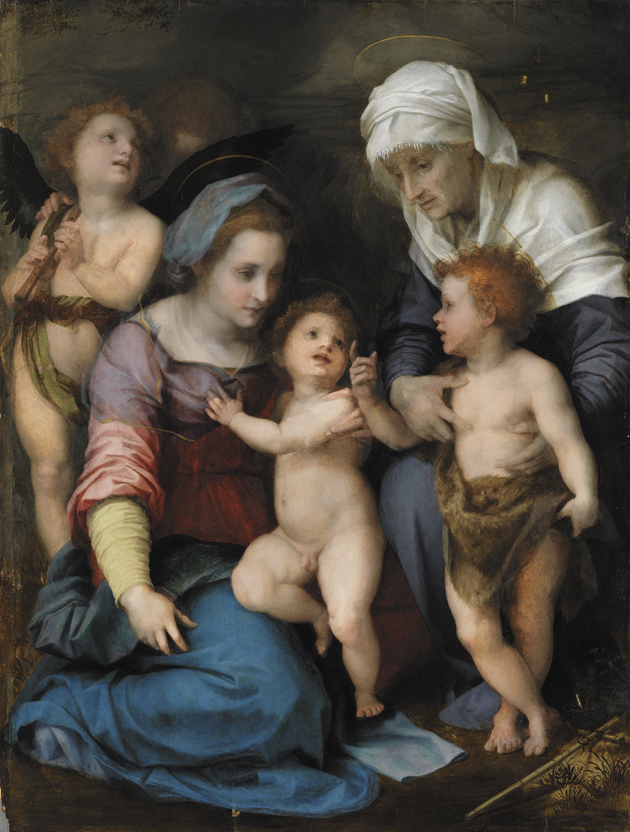Extravagant shows of old master art have been one of the most significant cultural phenomena of recent decades. Just as music festivals celebrate the giants of music history, museums in London, New York, Washington, and Paris highlight the great painters and sculptors of the past. In Germany, however, this blockbuster culture has never really taken hold, which sometimes surprises and disappoints curators in other countries. Of course, there have been some first-rate exceptions such as the Rembrandt show in Berlin and the Adam Elsheimer show at Frankfurt’s Städel Museum, both in 2006. But the blockbuster whirlwind has almost completely bypassed Munich, with its more low-key and conservative museum culture.
Yet along with such music festival–like extravaganzas, there are also on occasion much smaller exhibitions, ones that are more like chamber music concerts. These are shows in which a museum displays a single treasure from its collection together with a few comparable works, accompanied by documents illuminating its history or the technique used by its author. Such shows are less costly and more concentrated and informative than blockbusters. They encourage leisurely observation and critical comparison. As Paul Claudel wrote, “The eye listens.” Munich is fortunate to have had a series of such shows in the Alte Pinakothek. They have brought visitors closer to Rubens’s Lion Hunt, the moonlit magic of Elsheimer’s Flight into Egypt, Tintoretto’s Gonzaga cycle, and Leonardo’s The Madonna of the Carnation.
In its current exhibition, “Divinely Painted—Andrea del Sarto: The Holy Family in Munich and Paris,” nothing less is at stake than the rehabilitation of a neglected masterpiece from the Alte Pinakothek’s own collection and aesthetic vindication for a genius of Italian painting who has long suffered undeserved censure. Andrea del Sarto, the son of a tailor, was born in Florence in 1486 and died there of the plague in 1530. His beginnings as a painter thus coincided with the flowering of the Florentine Renaissance under Leonardo, Michelangelo, and Raphael. Apart from a brief stay at the French court in 1518, Andrea seems hardly ever to have left his native city, where, beginning in about 1515, he achieved the highest renown.
He painted religious subjects almost exclusively, most often the Madonna or the Holy Family. Andrea seems to have been a pious man. His self-portrait in the Uffizi shows him with a rounded, sensitive face, lacking pretense but with a hint of ironic bashfulness. Suffused with a hovering, poetic magic, his works are never strident and avoid overbearing pathos. Andrea was above all a divine colorist who avoided tones that make a shrill or brilliant impression, deploying instead a palette of shimmering warmth played about by shadow. There is something of Leonardo, something of Raphael in them, but the gentle beauty of Andrea’s paintings remains unmistakably his own.
Andrea del Sarto’s critical history has been marked by a scandalous defamation of his character and disparagement of his work. During his life, he received only the highest praise; and even in the late seventeenth century, Filippo Baldinucci still celebrated him as the greatest Tuscan painter. But Andrea’s memory had been besmirched by Vasari in his Lives—first published in 1550—with a genuine mala lingua. Andrea lacked the courage, he wrote, to remain true to his incomparable talent. Worse: he neglected his art under the influence of his monster of a wife. He was morally depraved, embezzled money, and even failed to support his impoverished parents. From the weakness of Andrea’s character Vasari infers the supposed weakness of his art.
This is gossip in the style of an Italian novelletta; Vasari must have had some grudge against Signora Lucrezia. Yet his slander of Andrea has cast a long shadow. Even in the past century, the vilified painter was still regarded as a great painter lacking in bravura, a man with weaknesses. The great Swiss art critic Heinrich Wölfflin himself decreed from his lectern, “Among the talents of the highest order, he is the only one who seems to have had a defect in his moral constitution.”
It was John Shearman—one of those English art historians for whom all theory is suspect and the true aim of the profession is a precise reading of pictures and primary sources—who, in 1965, overturned Vasari’s verdict. While there may well be some validity to the certa timidità Vasari attributed to Andrea, we are now compelled to see such “timidity” not as a defect but as a distinct virtue of this gentle, restrained painter. In painting, poetry, and music, the muted voices are not the worst by any means.
The Alte Pinakothek in Munich owns one of Andrea’s masterpieces, The Holy Family with John the Baptist, Elizabeth, and Two Angels (circa 1514). Painted on a poplar panel, it shows John the Baptist and his mother Elizabeth paying a visit to Mary and the toddler Jesus. This was a popular motif in Florentine paintings since John the Baptist was the patron saint of the city. To judge from the several existing copies of it, Sarto’s composition must have been highly regarded. There is a version in the Louvre that was long considered the original; the Munich panel, in contrast, had been damaged by restorations, and was viewed as a copy of the original in Paris and perhaps not even by Andrea’s own hand.
Advertisement
Again, it was John Shearman who rejected this dismissing view. Through examination of the pentimenti and a convincing interpretation of Vasari’s reporting, he made a plausible case for the Munich painting as the original version, the one Andrea intended for Francis I and entrusted to the Florentine silk merchant Puccini to convey to France. Puccini liked it so much, however, that he kept it for himself. The Paris picture, on the other hand, may have been painted later by Andrea for the French king.
Shearman’s analysis stirred Cornelia Syre, the Alte Pinakothek’s curator of Italian painting, and her colleagues to restore the Munich version of Andrea’s work so that its colors gleam in undiminished enchantment. The exhibition has brought the Paris picture to Munich for comparison. Now that the two versions hang triumphantly side by side on an octagonal platform, it is clear that the Munich painting is the richer invention. The viewer is captivated by the flesh tones and colors of the garments that seem to shimmer through a veil. It explores more deeply and thoroughly the mysteries of this moment in the story of salvation. The Paris version is more dramatic but also more showy, particularly in the depiction of the face of Mary and the movements of Christ and John the Baptist. Its touch of Michelangelo’s histrionics is owing perhaps to its royal commission. The comparison of the two paintings—enhanced by the infrared photos of both works that are on display in a side room—is the show’s immeasurable reward. The Alte Pinakothek has gained a masterpiece—not through acquisition, but through research and restoration.
The exhibition also includes twelve marvelous drawings, preliminary studies, which are arranged around the two paintings like echoes. Andrea uses red chalk so that on paper, too, he achieves the delicate transitions from highlights to shadows that constitute the magic of his paintings. There are studies of hands for the Munich painting. Other sheets show the care with which Andrea prepared the arrangement of folds in his figures’ garments. On another, depicting a young boy drawn in various poses, we can see how true to life this artist could be. He was a poet, but not a dreamer.
One might question whether so much needs to be written about so small an exhibition. The answer is yes, absolutely. Museums are facing dramatic changes under the pressures of digitalization, globalization, and the tendency to display a variety of cultures, and they are trying to attract broad audiences for their shows. They need niches like this one. The multifarious treasures of the Alte Pinakothek are well suited to the task. But such explorations require attentive conservators and art historians who are not trying to display their own brilliance but who are able to do empirical research on artworks themselves. This small, sublime exhibition should show the way.
—Translated from the German by David Dollenmayer
This Issue
January 14, 2010




